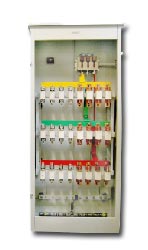How to maintain and replace fuses
Fuses change their characteristics during long-term use — they "get old". Therefore, they must be periodically replaced with new ones.
Maintenance of the fuses is reduced to monitoring the condition of the contact connections and replacing blown fuses with factory-made spares.
Use of "bugs" in fuses
 In practice, the fuse is often replaced with a copper one. wire, which is fixed on the outer surface of the cartridge, — the so-called "bugs". When the "bug" burns, the porcelain can be destroyed. fuses as well as heating of fuses, as a result of which there may be a fire. Using uncalibrated copper wire instead of fusing wire inserts is also unacceptable from the point of view of safe operation of the fuses, because if it accidentally burns during the fuse check, it is easy to get an eye injury or a hand burn.
In practice, the fuse is often replaced with a copper one. wire, which is fixed on the outer surface of the cartridge, — the so-called "bugs". When the "bug" burns, the porcelain can be destroyed. fuses as well as heating of fuses, as a result of which there may be a fire. Using uncalibrated copper wire instead of fusing wire inserts is also unacceptable from the point of view of safe operation of the fuses, because if it accidentally burns during the fuse check, it is easy to get an eye injury or a hand burn.
How to change fuses
When replacing fuses, strictly follow safety rules.
Fuses must be replaced with the voltage removed.If for such reasons the voltage cannot be removed, the fuses are replaced with dielectric gloves or with the help of pliers.
For safe maintenance of the PN2 type fuse, there are T-shaped protrusions on the cartridge covers, for which the fuse holder can be removed from the contact racks in the absence of circuit load, a special handle suitable for all PN2 series cartridges.
Types of electrical protection of asynchronous electric motors
Selection of fuses for protection of asynchronous motors
Selection of fuses for the protection of overhead lines 0.4 kV
Types of failures and protection of static capacitor banks (BSC)
Installation of an electrical panel — circuit diagram, recommendations
